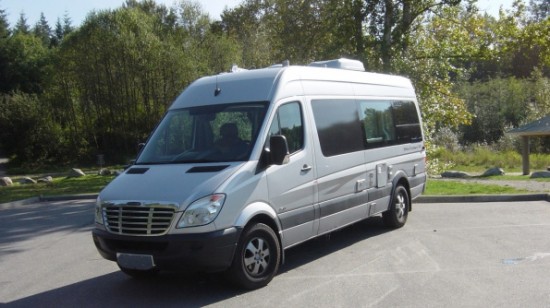 “So how many miles per gallon can you really get in a Sprinter?”, everybody asks. Aside from the facts that ours is not a daily driver, and we’re not actively hypermiling, I’d say the mileage is good: we average 18-22 mpg, even in the mountains of Colorado at speeds of 60-80 mph. Very good fuel economy compared to my old Dodge Tradesman, which had a 5.7-liter V8 that got about 6-8mpg, and better than a V8 E350, that seems to get around 15 mpg. But all these are easy numbers to throw around, how do you find hard fuel mileage data for a Sprinter?
“So how many miles per gallon can you really get in a Sprinter?”, everybody asks. Aside from the facts that ours is not a daily driver, and we’re not actively hypermiling, I’d say the mileage is good: we average 18-22 mpg, even in the mountains of Colorado at speeds of 60-80 mph. Very good fuel economy compared to my old Dodge Tradesman, which had a 5.7-liter V8 that got about 6-8mpg, and better than a V8 E350, that seems to get around 15 mpg. But all these are easy numbers to throw around, how do you find hard fuel mileage data for a Sprinter?
Enter Fuelly and some similar Web sites, where drivers enter their vehicle details and their mileage. Fuelly has 18 Dodge Sprinters of various years profiled on their site, showing the fuel mileage they’re reporting, the number of fill-ups the data comes from, and often pictures of the vehicles themselves. Another resource is the Yahoo Sprintervan group, where members can check out fuel mileage stats for 74 Sprinters listed there. Now, none of the Sprinters listed on Fuelly is a natural-gas-powered Sprinter like Mercedes is selling in Europe (supposedly the most fuel-efficient Sprinters out there), but at least one is running biodiesel (if you still think that biodiesel Sprinters will get lousy fuel mileage, read my post quoting biodiesel Sprinter drivers – not so!).
Really want to get geeky and consider factors in a Sprinter’s fuel economy? Sure, better driving habits help, but there’s also the pieces and parts of your Sprinter to think about:
- Smaller engine – The 2.7-liter diesel sips less fuel than the 3.0-liter engine, which is a no-brainer. The most impressive reported fuel mileage I’ve seen is 32 mpg, reported for a night trip at 55mph in a 2004 Sprinter 2500 170″ high-roof with a 2.7-liter diesel engine. Less power too, but that may not be an issue…
- Diesel Particulate Filter (DPF) – If you own a pre-2007 Sprinter, you don’t have one. But if your Sprinter is post-2006, and this is dirty, it’s probably affecting your mileage – the Sprinter cleans its own DPF periodically by burning off the particulates in a process called “DPF regeneration”, but you may need to commercially clean the DPF or replace it, eventually.
- Axle ratio – If you have a Sprinter passenger van, you might have a 3.92 axle ratio, like my 2008 Sprinter 144″. But often a Sprinter 3500 may have a 4.10 or 4.18 axle ratio, and these will carry loads better, but have poorer fuel mileage.
- Load – If you’re towing a trailer, or have a Sprinter RV conversion that is sagging on its springs, you know your fuel mileage isn’t going to be the best!
- Speed – More speed requires more RPMs, and more fuel. So what’s the best speed for optimum fuel mileage? Just like the old-fashioned US highway speed limit, many Sprinter owners say 55-60 mph will get you the best mileage possible.
To watch your mileage and engine in detail, get yourself a ScanGauge II or Bullydog WatchDog. With one of these installed, you can watch the real-time performance of your engine and its vital statistics, including RPMs, percentage of load, engine temperature, etc. If you keep engine RPMs in the most efficient range (near 3800 RPM for OM642 V-6 engines, near 3300 RPM for OM647 I5 engines), temperatures for your engine, transmission and coolant will be lower, and you’ll get better mileage and require less maintenance.




Comments on this entry are closed.